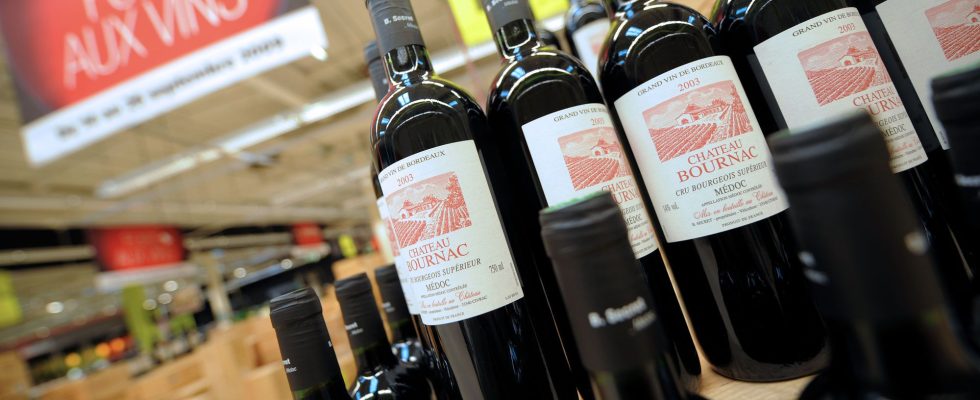Like every year, in September, the harvest time is accompanied by that of the wine fairs. The autumn meeting of large retailers with bottle diving enthusiasts has become unmissable. In one month, some 140 million bottles will pass from gondolas to consumers’ shopping carts, happy to combine great discoveries and good deals. An important commercial issue for brands, which achieved 1 billion euros in turnover during the event in 2022, or 15% (on average) of their annual wine sales*.
How far we have come since the invention of these Bacchic high masses, in 1973, by two members E.Leclerc from Brittany, in Vannes and Saint-Pol-de-Léon. For the first time, the star litrons of jaja gave way to quality wines. Result of these iconoclastic sales – at the bottom of the truck! -, in the store parking lot: 80,000 bottles sold and a revenue of 240,000 francs. An extraordinary success in France in the 1970s. And which continues: fifty years later, the group founded by Edouard Leclerc remains at the top of the market. At the time, only a cooperative and a Bordeaux merchant participated in the operation. These pioneers were joined, over the years, by many of their colleagues from the Port de la Lune, attracted by the incredible success of the event, which other brands quickly took over. A partnership that has never wavered, making Bordeaux classified growths the irremovable stars of the fairs. The ace ! For around fifteen years, the dizzying prices of many chosen in the 1855 classification have kept them away from the shelves. Only specialized e-commerce sites, often from the Bordeaux trade, maintain them in the catalog. So mass distribution adapted and rethought its model. The wines of Entre-deux-Mers and the north of Gironde – often organic – today carry the standard of the region. But if Bordeaux remains very present (25% of sales last year), notably at E.Leclerc, Intermarché and Auchan, they must deal with numerous vintages representative of the richness and diversity of the terroirs of France.
Prestigious ambassadors
Now, all the production regions appear on the map of the largest cellar in France. All that remains is to diversify supplies, distinguish selections and surprise to attract customers. Faced with plethora of offers (1,700 references at Carrefour and Intermarché, while E.Leclerc, Casino and U stores account for around half), to reassure small producers – and consumers -, nothing better than to attach services of personalities from “mondovino”. Andreas Larsson, best sommelier in the world, has collaborated since 2013 with E.Leclerc, the renowned critics Michel Bettane and Thierry Desseauve watch over the favorites of the Monoprix Gourmet jury, and Carrefour has commissioned The French Wine Review to distinguish and note its “nuggets”.
The winegrowers themselves, whose reels illustrate most of the fair catalogs, are enlisted in the adventure. Without forgetting some celebrities and vineyard heavyweights, such as Bernard Magrez, Gérard Bertrand, Jean-Claude Mas, Gérard Depardieu, Nicolas Grosbois, Romain Duvernay, Jean Guyon, Xavier Vignon… A name dropping which says a lot about the move upmarket of the overall offering. Also illustrated by the finds of the U Stores Wine and Terroir Club, easily identifiable thanks to their purple collar, and those of the Casino Sommeliers Club.
Some brands even recruit famous sommeliers to create special vintages, such as Gérard Margeon (Ducasse group) and Eric Beaumard (George V) for Carrefour. In a nod to the Rugby World Cup, Intermarché asked stars of the oval ball and starred chefs from Occitanie to sign ad hoc blends, such as Christophe Dominici, Sébastien Chabal, Gilles Goujon, and Michel Sarran. The essay should be transformed without difficulty.
Top prices at less than 3 euros
This 2023 edition also confirms the trends observed in recent years. Firstly, the desire of major brands to stick as closely as possible to consumer tastes. This wine merchant spirit is highlighted by the breakthrough of labels displaying an environmental certificate, notably HVE, because the share of wines labeled organic and biodynamic rarely exceeds 10% of references, except in U stores, where it reaches 28%. Well seen: according to the latest Sowine/Dynata barometer, more than half of buyers would be sensitive to the “green” approach (67% among 18-25 year olds).
The pricing argument, moreover, has become essential in a context of high inflation and economic uncertainties. The big players in wine fairs rely on low prices. Monoprix, for example, claims 70% of vintages between 5 and 15 euros. Carrefour announces 12 IGP or AOC at 2.49 euros (reduced to 1.66 per batch of six), when a quarter of Auchan’s offer does not exceed 5 euros, 75% of that of Lidl is less than 10 euros, and 250 skittles from Intermarché are priced below 7 euros.
Internet distributors and wine merchants are also part of this trend: half of the Wineandco selection caps at 15 euros, 20% at Lavinia.
Wine merchants 2.0
Finally, faced with competition from online sales sites, such as Veepee, Vinatis, Chateaunet or XO-Vin, large stores have invested in the Web to develop new services. A good way to attract young active wine lovers, experienced in online purchasing, and to collect useful information on profiles and consumption habits. Customers can choose their bottles in advance from national (or regional) offers and collect them from the drive-thru of a store near their home. This click and collect, launched by Carrefour ten years ago, is proving more effective than attending the inauguration evenings, where the most beautiful bottles fly away. This service is now provided by most brands. Better still, some reserve exclusive, rather high-end offers on their site: 300 on E.Leclerc100 on macave.carrefour.fr40 on lidl-vins.fr. Hurry up, there won’t be something for everyone! And, to help you in your choices, find our selection by terroir on the following pages.
*Nielsen ScanTrack Panel.
